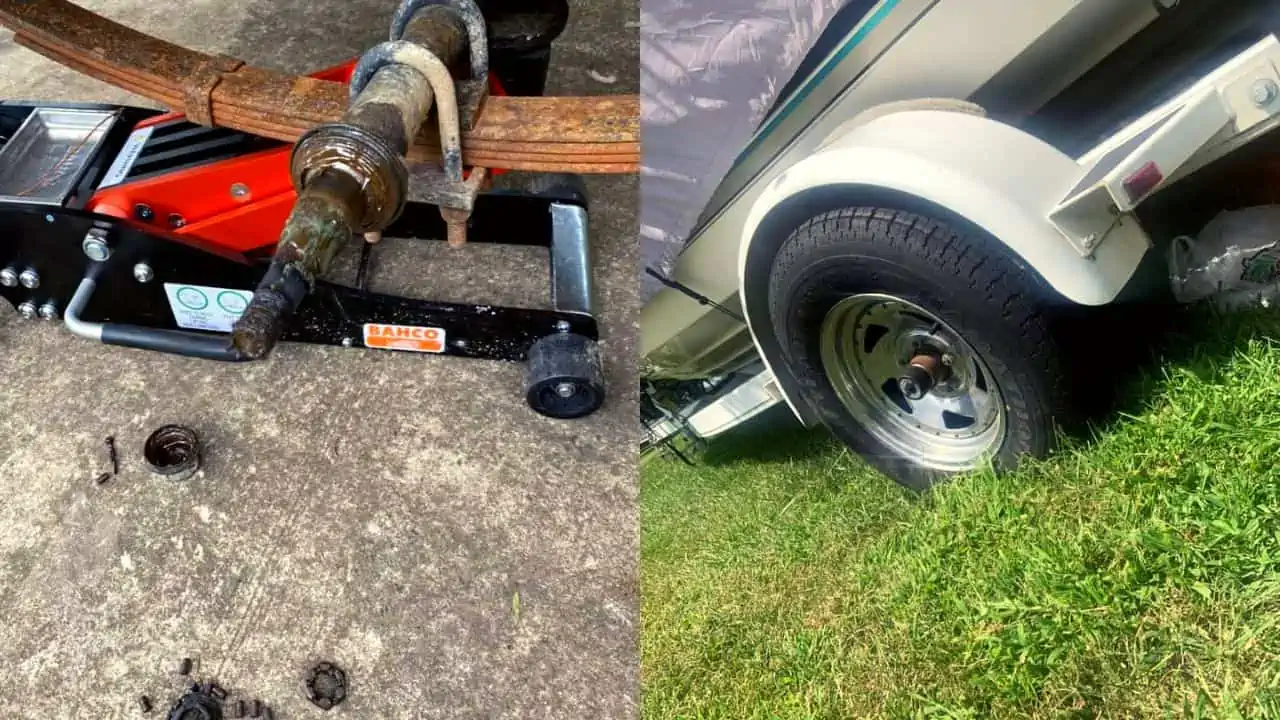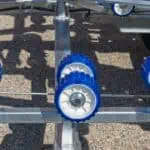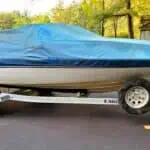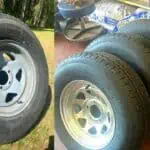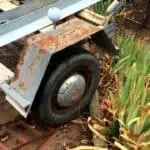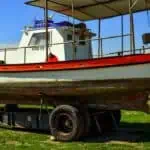If you’re like most boat trailer owners, you probably don’t think about your wheel bearings until there’s a problem. But a little preventive maintenance can go a long way toward extending the life of your bearings and avoiding costly repairs down the road.
- Park your boat trailer on level ground and set the emergency brake
- Jack up each wheel of the trailer one at a time, so that the tire is suspended in the air
- Spin the tire slowly by hand and feel for any roughness or resistance in the rotation
- If you feel any grinding, popping, or other abnormal resistance, this indicates a problem with the bearings and they will need to be replaced
- Repeat this process for each wheel on the trailer to check all of the bearings
How to Check Boat Trailer Wheel Bearings?
How Do I Know If My Boat Trailer Wheel Bearings are Bad?
If your boat trailer’s wheel bearings are bad, you’ll likely notice several symptoms. The most common symptom is a loud grinding noise coming from the wheels when you’re driving. This noise will be especially pronounced when you’re turning or braking.
Other symptoms can include the trailer shaking or wobbling, difficulty steering, and increased wear on the tires. If you suspect that your boat trailer’s wheel bearings are going bad, it’s important to have them checked out by a professional as soon as possible.
How Do You Know If Trailer Bearings are Bad?
If you’re wondering how to tell if your trailer bearings are bad, there are a few things you can look for. First, check the grease on the bearings. If it’s black and oily, that’s a sign that the bearings need to be replaced.
Second, check for any looseness in the bearings. If they feel loose or wobbly, that’s another indication that they need to be replaced. Finally, listen for any strange noises coming from the area of the bearings.
If you hear squealing or grinding, those are signs that the bearings need to be replaced.
How Do I Know If My Trailer Needs New Bearings?
If your trailer is starting to make strange noises, or if it’s becoming difficult to tow, then it’s possible that the bearings need to be replaced. There are a few ways to tell for sure:
1. Check the grease. If it’s black and gritty, then it’s time for new bearings.
2. Check the hub temperature. If it feels hot to the touch, that means the bearings are overworked and need to be replaced.
3. Pull out the bearing cap and take a look. If the bearings look worn or damaged, they need to be replaced.
How Often Should Bearings Be Replaced on a Boat Trailer?
Trailer bearings should be replaced every two years or sooner if they show signs of wear. Bearings should be inspected annually and repacked with grease if necessary.
How Do You Visually Check Wheel Bearings?
If you’re like most people, you probably don’t think about your wheel bearings until there’s a problem. But these crucial components play an important role in keeping your car safe and running smoothly. Here’s what you need to know about wheel bearings, including how to visually check them for signs of wear and tear.
What is Wheel Bearings? Wheel bearings are metal balls that sit inside a metal ring called races. The races are mounted on the axle shaft or hub, and the whole assembly sits inside the wheel.
As the name implies, wheel bearings help support the weight of the vehicle and allow the wheels to rotate freely. Over time, however, wheel bearings can wear down from use or due to exposure to water or other road debris. When this happens, they can start to make noise (usually a grinding sound) or cause the wheels to vibrate.
In extreme cases, they can even fail, which can lead to disastrous results if it happens while you’re driving! That’s why it’s important to periodically check your wheel bearings for signs of wear and tear. Here’s how to do it:
How to Check Your Wheel Bearings Visually The best way to check your wheel bearings is by lifting your vehicle and inspecting them directly. If you don’t have access to a lift, you can also jack up each corner of the car one at a time (making sure to use jack stands for safety).
Once the vehicle is off the ground:
How Tight Should Boat Trailer Bearings Be?
Boat trailer bearings are one of the most important components of your trailer. They enable your trailer to roll smoothly down the road, and they keep your boat safe while you’re driving. But how tight should boat trailer bearings be?
The answer may surprise you – boat trailer bearings should be quite loose. That’s because when you’re driving down the road, the bearings will heat up and expand. If they’re too tight, this expansion can cause damage to the bearings or even cause them to fail.
Of course, there is a balance to be struck here. The bearings shouldn’t be so loose that they fall out or allow too much movement in the axle. You’ll need to experiment a little bit to find the right level of looseness for your particular setup, but as a general rule, it’s better to err on the side of caution and go with slightly loose bearings rather than risk damaging them by making them too tight.
How to Tell If Trailer Wheel Bearings Need to Be Replaced
If you’re like most RVers, you probably don’t give your trailer’s wheel bearings much thought – that is, until they start making noise. Then, it’s time to take action to prevent further damage to your trailer. Here’s a quick guide on how to tell if your trailer’s wheel bearings need to be replaced.
One of the first signs that your trailer’s wheel bearings may be going bad is if the wheels start to wobble when you’re driving. This is usually caused by either a loose bearing or one that has failed. If you notice this while driving, pull over as soon as possible and inspect the bearings.
Another sign that your trailer’s wheel bearings need attention is if you hear a grinding noise coming from the wheels while driving. This can also be caused by either a loose bearing or complete failure and should be inspected immediately. If you notice any of these symptoms, it’s important to act quickly and replace the affected bearings.
Wheel bearing failure can cause serious damage to your trailer – not to mention putting yourself and other motorists at risk on the roadways. So don’t delay – get those trailers rolling smoothly again with fresh new bearings!
How to Check Travel Trailer Wheel Bearings
If you’re planning a road trip in your travel trailer, it’s important to make sure that your wheel bearings are in good condition before you hit the open road. Here’s a quick guide on how to check your travel trailer’s wheel bearings:
1. Jack up the trailer and remove the wheels. This will give you a clear view of the bearings and hub assembly.
2. Inspect the bearings for any signs of damage or wear. Look for any cracks, chips, or other damage on the surface of the bearing. Also, check that the bearing is not excessively loose in the hub assembly.
3. If everything looks okay, repack the bearings with fresh grease and re-install them into the hubs. Ensure you don’t over-tighten the axle nut when putting everything back together.
4. Lower the trailer back down and test drive it to make sure that everything is working properly.
How to Grease Trailer Wheel Bearings
If you’ve ever taken your trailer out on the road, you know that properly greased wheel bearings are essential for a smooth ride. Here’s a quick guide on how to grease trailer wheel bearings: First, make sure your trailer is parked on level ground and the wheels are chocked.
This will ensure that the trailer doesn’t move while you’re working on it. Next, remove the dust cap from the hub. You’ll see a large nut in the center of the hub – this is what secures the bearing in place.
Using a wrench or socket, loosen this nut until it’s loose enough to turn by hand. Don’t remove it completely – just loosen it so that you can spin the hub. Once the nut is loosened, spin the hub slowly by hand.
You should feel resistance as you spin – this is normal and means that the bearings are still greased. If there’s no resistance or if the resistance feels uneven, then it’s time to add more grease. To add grease, simply insert a grease gun into one of the zerk fittings (the metal fittings where grease enters) and squeeze the trigger until fresh grease appears at all four zerk fittings around the circumference of the hubcap equally.
It’s important to use fresh grease – old or contaminated grease can damage bearings. Once you’ve added fresh grease, spin the hub again by hand to distribute it evenly. Then replace the dust cap and tighten the central nut until snug.
Be careful not to over-tighten – just snug it up so that there’s no chance of movement. And that’s it! By following these simple steps, you can keep your trailer wheels rolling smoothly mile after mile.
Boat Trailer Bearings Kit
If you have a boat, you need a boat trailer to haul it around. And if you have a boat trailer, you need a boat trailer bearings kit to make sure the trailer rolls smoothly. Here’s everything you need to know about boat trailer bearings kits.
A boat trailer bearings kit typically includes the bearings, races, seals, and hub caps needed to replace the existing ones on your trailer. The bearings allow the wheels to rotate freely and with as little friction as possible. The races fit snugly around the bearing so that it doesn’t move around too much within the wheel hub.
The seals keep water and dirt out of the bearing area, and the hub caps protect the whole assembly from damage when not in use. Installing new bearings is not a difficult task, but it is important to do it correctly so that your trailer performs well and lasts for many years. First, you’ll need to remove the old bearings from the hubs using a hammer and chisel or an impact wrench (if they’re stuck).
Next, clean out any debris from inside the hub using compressed air or a wire brush. Then simply tap in the new races using a soft-faced mallet until they’re flush with the edge of the hub opening, being careful not to damage them. Slide in the new bearings and hand-tight the retaining nut until it’s snug against the bearing (don’t overtighten!).
Finally, install the new seals by tapping them into them and place them with a mallet or block of wood wrapped in cloth (again, be careful, not tomisdealignor damage them). With fresh new bearings installed, your boat trailer will tow more easily behind your vehicle and provide years of trouble-free service.
Best Grease for Boat Trailer Bearings
If you own a boat, chances are you also own a boat trailer. And if you own a boat trailer, then you know that one of the most important parts of maintaining your trailer is keeping the bearings in good shape. But what kind of grease should you use for your boat trailer bearings?
There are a few different types of grease that can be used on boat trailer bearings, but the best type to use is marine-grade grease. Marine-grade grease is designed to withstand the harsh conditions that come with being used in salt water. It’s also made to resist corrosion and degradation, which means it will last longer and keep your bearings working better for longer.
So if you’re looking for the best grease to use on your boat trailer bearings, go with marine-grade grease. Your bearing will thank you for it!
Boat Trailer Bearing Maintenance
Assuming you are talking about boat trailer bearings: Boat trailer bearings are one of the most important parts of your trailer. Without properly functioning bearings, your trailer cannot move.
This makes it difficult to load and unload your boat. In addition, poorly maintained bearings can cause damage to your boat and trailer. Bearing maintenance is not difficult, but it is important to do it regularly.
At a minimum, you should inspect your bearings every time you use your trailer. You should also repack them with grease every few months, or as needed depending on how often you use your trailer. To inspect your bearings, first, remove the hub cap or dust cover.
Next, check the condition of the grease inside the hub. If it looks dirty or has chunks in it, it’s time to repack the bearing. To do this, simply remove all of the old greases from the hub and pack it with new grease until it is full.
Be sure to use marine-grade grease designed for boat trailers; regular automotive greases will not work as well in wet conditions. If you notice any damage to the bearing itself ( cracks or rust), replace it immediately. Bearings are relatively inexpensive and easy to replace, so there is no reason to risk further damage by continuing to use a damaged bearing.
Once you have inspected and/or replaced your bearings, be sure to put the dust cover or hub cap back in place before hitting the road.
How Much Play in Trailer Wheel Bearings
If you’re like most people, you probably don’t think much about your trailer wheel bearings. But these small components play a big role in keeping your trailer rolling down the road. So how much play should there be in your trailer wheel bearings?
The answer is not as simple as you might think. There are two types of play that can occur in trailer wheel bearings: radial play and axial play. Radial play is the amount of side-to-side movement that can occur in the bearing.
This type of play is usually caused by wear and tear on the bearing itself or the races it sits in. Radial play can also be caused by an incorrect installation of the bearing. Axial play is the amount of up-and-down movement that can occur in the bearing.
This type of play is usually caused by an incorrect installation of the bearing or by wear and tear on the races or seals. Axial play can also be affected by changes in temperature (expansion and contraction). So how much radial and axial play should there be in your trailer wheel bearings?
The answer depends on several factors, including: -the type of bearing -the size of the bearing
-the load being carried -the speed at which you’re traveling speeds That said, most experts agree that there should be no more than .002″ (0.05mm)of radial play and .004″ (0.1mm)of axialplayin anytrailerwheelbearing.
How to Replace Boat Trailer Bearings
Boat trailer bearings are an essential part of towing your vessel. They allow the wheels to rotate freely and provide support for the weight of your trailer. Over time, however, these bearings can become worn down and need to be replaced.
Replacing boat trailer bearings is not a difficult task, but it is important to do it correctly to avoid any damage to your trailer or boat. The first step is to remove the old bearings from the hub assembly. You will need a bearing puller for this task.
Once the old bearings are removed, clean out the hub assembly with a wire brush or similar tool. All debris and old grease must be removed before installing new bearings. Next, you will need to install the new inner bearing into the hub assembly.
Again, everything must be clean and free of debris before doing this. Once the new inner bearing is in place, you can put some fresh grease into the hub assembly before installing the outer bearing. Make sure that you pack enough grease around both sides of the bearing so that it is fully seated in its housing within the hub assembly.
Finally, re-install the dust cover onto the hub assembly and replace any cotter pins or other retaining hardware that was removed during disassembly. Once everything is back in place, spin each wheel by hand to make sure that they rotate freely without any binding or resistance. If everything feels good, then you’re ready to hitch up your boat trailer and head out on your next adventure!
Conclusion
If you’re like most boat owners, you probably don’t give your trailer’s wheel bearings much thought. But, if you’re not regularly maintaining them, they can cause some serious problems down the road. Here’s a quick guide on how to check your boat trailer’s wheel bearings:
First, jack up the front of the trailer and remove the wheels. Next, take a look at the bearings themselves. If they look corroded or damaged in any way, it’s time to replace them.
If the bearings look okay, clean them off with some brake cleaner and repack them with fresh grease. Finally, reassemble everything and lower the trailer back down.
Checking your boat trailer’s wheel bearings is a pretty simple task that only takes a few minutes.
However, it’s an important part of regular maintenance that will help keep your trailer in good condition for years to come.
